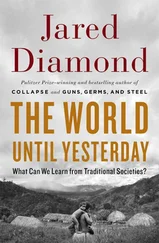Jared Diamond - Guns, Germs & Steel
Здесь есть возможность читать онлайн «Jared Diamond - Guns, Germs & Steel» весь текст электронной книги совершенно бесплатно (целиком полную версию без сокращений). В некоторых случаях можно слушать аудио, скачать через торрент в формате fb2 и присутствует краткое содержание. Жанр: 105. Описание произведения, (предисловие) а так же отзывы посетителей доступны на портале библиотеки ЛибКат.
- Название:Guns, Germs & Steel
- Автор:
- Жанр:
- Год:неизвестен
- ISBN:нет данных
- Рейтинг книги:5 / 5. Голосов: 1
-
Избранное:Добавить в избранное
- Отзывы:
-
Ваша оценка:
- 100
- 1
- 2
- 3
- 4
- 5
Guns, Germs & Steel: краткое содержание, описание и аннотация
Предлагаем к чтению аннотацию, описание, краткое содержание или предисловие (зависит от того, что написал сам автор книги «Guns, Germs & Steel»). Если вы не нашли необходимую информацию о книге — напишите в комментариях, мы постараемся отыскать её.
Guns, Germs & Steel — читать онлайн бесплатно полную книгу (весь текст) целиком
Ниже представлен текст книги, разбитый по страницам. Система сохранения места последней прочитанной страницы, позволяет с удобством читать онлайн бесплатно книгу «Guns, Germs & Steel», без необходимости каждый раз заново искать на чём Вы остановились. Поставьте закладку, и сможете в любой момент перейти на страницу, на которой закончили чтение.
Интервал:
Закладка:
3 O 8 • GUNS, GERMS,and steel
Moluccas and truncated Indonesia's separate train of developments. When Europeans reached New Guinea soon thereafter, its inhabitants were still living in bands or in fiercely independent little villages, and still using stone tools.
while the new Guinea hemi-continent of Greater Australia thus developed both animal husbandry and agriculture, the Australian hemi-continent developed neither. During the Ice Ages Australia had supported even more big marsupials than New Guinea, including diprotodonts (the marsupial equivalent of cows and rhinoceroses), giant kangaroos, and giant wombats. But all those marsupial candidates for animal husbandry disappeared in the wave of extinctions (or exterminations) that accompanied human colonization of Australia. That left Australia, like New Guinea, with no domesticable native mammals. The sole foreign domesticated mammal adopted in Australia was the dog, which arrived from Asia (presumably in Austronesian canoes) around 1500 b.c. and established itself in the wild in Australia to become the dingo. Native Australians kept captive dingos as companions, watchdogs, and even as living blankets, giving rise to the expression "five-dog night" to mean a very cold night. But they did not use dingos / dogs for food, as did Polynesians, or for cooperative hunting of wild animals, as did New Guineans.
Agriculture was another nonstarter in Australia, which is not only the driest continent but also the one with the most infertile soils. In addition, Australia is unique in that the overwhelming influence on climate over most of the continent is an irregular nonannual cycle, the ENSO (acronym for El Nifio Southern Oscillation), rather than the regular annual cycle of the seasons so familiar in most other parts of the world. Unpredictable severe droughts last for years, punctuated by equally unpredictable torrential rains and floods. Even today, with Eurasian crops and with trucks and railroads to transport produce, food production in Australia remains a risky business. Herds build up in good years, only to be killed off by drought. Any incipient farmers in Aboriginal Australia would have faced similar cycles in their own populations. If in good years they had settled in villages, grown crops, and produced babies, those large populations would have starved and died off in drought years, when the land could support far fewer people.
The other major obstacle to the development of food production in
YALI'S PEOPLE • 309
Australia was the paucity of domesticable wild plants. Even modern European plant geneticists have failed to develop any crop except macadamia nuts from Australia's native wild flora. The list of the world's potential prize cereals—the 56 wild grass species with the heaviest grains—includes only two Australian species, both of which rank near the bottom of the list (grain weight only 13 milligrams, compared with a whopping 40 milligrams for the heaviest grains elsewhere in the world). That's not to say that Australia had no potential crops at all, or that Aboriginal Australians would never have developed indigenous food production. Some plants, such as certain species of yams, taro, and arrowroot, are cultivated in southern New Guinea but also grow wild in northern Australia and were gathered by Aborigines there. As we shall see, Aborigines in the climatically most favorable areas of Australia were evolving in a direction that might have eventuated in food production. But any food production that did arise indigenously in Australia would have been limited by the lack of domesticable animals, the poverty of domesticable plants, and the difficult soils and climate.
Nomadism, the hunter-gatherer lifestyle, and minimal investment in shelter and possessions were sensible adaptations to Australia's ENSO-driven resource unpredictability. When local conditions deteriorated, Aborigines simply moved to an area where conditions were temporarily better. Rather than depending on just a few crops that could fail, they minimized risk by developing an economy based on a great variety of wild foods, not all of which were likely to fail simultaneously. Instead of having fluctuating populations that periodically outran their resources and starved, they maintained smaller populations that enjoyed an abundance of food in good years and a sufficiency in bad years.
The Aboriginal Australian substitute for food production has been termed "firestick farming." The Aborigines modified and managed the surrounding landscape in ways that increased its production of edible plants and animals, without resorting to cultivation. In particular, they intentionally burned much of the landscape periodically. That served several purposes: the fires drove out animals that could be killed and eaten immediately; fires converted dense thickets into open parkland in which people could travel more easily; the parkland was also an ideal habitat for kangaroos, Australia's prime game animal; and the fires stimulated the growth both of new grass on which kangaroos fed and of fern roots on which Aborigines themselves fed.
310 • GUNS, GERMS, AND STEEL
We think of Australian Aborigines as desert people, but most of them were not. Instead, their population densities varied with rainfall (because it controls the production of terrestrial wild plant and animal foods) and with abundance of aquatic foods in the sea, rivers, and lakes. The highest population densities of Aborigines were in Australia's wettest and most productive regions: the Murray-Darling river system of the Southeast, the eastern and northern coasts, and the southwestern corner. Those areas also came to support the densest populations of European settlers in modern Australia. The reason we think of Aborigines as desert people is simply that Europeans killed or drove them out of the most desirable areas, leaving the last intact Aboriginal populations only in areas that Europeans didn't want.
Within the last 5,000 years, some of those productive regions witnessed an intensification of Aboriginal food-gathering methods, and a buildup of Aboriginal population density. Techniques were developed in eastern Australia for rendering abundant and starchy, but extremely poisonous, cycad seeds edible, by leaching out or fermenting the poison. The previously unexploited highlands of southeastern Australia began to be visited regularly during the summer, by Aborigines feasting not only on cycad nuts and yams but also on huge hibernating aggregations of a migratory moth called the bogong moth, which tastes like a roasted chestnut when grilled. Another type of intensified food-gathering activity that developed was the freshwater eel fisheries of the Murray-Darling river system, where water levels in marshes fluctuate with seasonal rains. Native Australians constructed elaborate systems of canals up to a mile and a half long, in order to enable eels to extend their range from one marsh to another. Eels were caught by equally elaborate weirs, traps set in dead-end side canals, and stone walls across canals with a net placed in an opening of the wall. Traps at different levels in the marsh came into operation as the water. level rose and fell. While the initial construction of those "fish farms" must have involved a lot of work, they then fed many people. Nineteenth-century European observers found villages of a dozen Aboriginal houses at the eel farms, and there are archaeological remains of villages of up to 146 stone houses, implying at least seasonally resident populations of hundreds of people.
Still another development in eastern and northern Australia was the harvesting of seeds of a wild millet, belonging to the same genus as the broomcorn millet that was a staple of early Chinese agriculture. The millet
Интервал:
Закладка:
Похожие книги на «Guns, Germs & Steel»
Представляем Вашему вниманию похожие книги на «Guns, Germs & Steel» списком для выбора. Мы отобрали схожую по названию и смыслу литературу в надежде предоставить читателям больше вариантов отыскать новые, интересные, ещё непрочитанные произведения.
Обсуждение, отзывы о книге «Guns, Germs & Steel» и просто собственные мнения читателей. Оставьте ваши комментарии, напишите, что Вы думаете о произведении, его смысле или главных героях. Укажите что конкретно понравилось, а что нет, и почему Вы так считаете.










